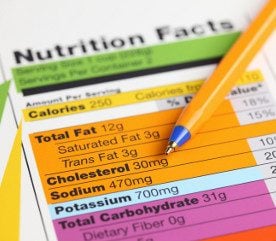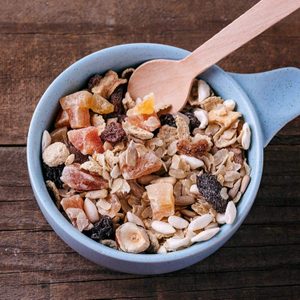Are You Eating the Right Things? Quiz
Check your food diary to help you to answer the following questions. For each, circle the number to the left of the answer that best reflects your choices.

1. I eat breakfast:
1 Hardly ever
2 Off and on
3 Every day
2. Between meals, I:
1 Don’t eat anything at all
2 Always have at least one large snack
3 Have a light snack if I feel hungry
3. I eat the most:
1 At my evening meal and throughout the evening
2 At lunch and throughout the afternoon
3 In the morning and at lunch
4. At lunch and dinner, I:
1 Rarely eat vegetables with my meal
2 Sometimes have a vegetable
3 Almost always have at least one vegetable or a salad
5. I eat fruit:
1 Seldom
2 A few times a week
3 One to three times a day
6. When I eat a carbohydrate food, it tends to be:
1 Chips or sugared cereals
2 White bread, pasta, white rice or mashed potatoes
3 Whole grain breads and cereals or starchy beans, such as kidney beans or other pulses
7. Most of the foods I eat tend to be:
1 Fast food or takeaway (Chinese, Indian, pizza)
2 Processed foods (packaged foods, ready meals)
3 Fresh (fruit, vegetables, meals cooked at home using fresh ingredients)
8. My biggest sources of calories are:
1 Desserts or snack foods
2 Meat and potatoes
3 Vegetables, fruits and whole grains
9. When I drink beverages, I prefer:
1 Regular soft drinks
2 Fruit juice
3 Diet drinks or water
10. I eat sugary foods such as biscuits, cakes and sweets:
1 More than once a day
2 About once a day
3 Less than once a day
11. The meats I eat the most tend to be:
1 Processed meats such as burgers, sausages or canned meat
2 Chicken with skin on, lamb, fatty cuts of meat or minced beef
3 Skinless chicken, extra-lean mince, lean beef, pork or ham
12. My meals consist of the same foods:
1 Four or more times a week
2 Three times a week
3 Once or twice a week or less
What Your Score Means
27 to 36 Your eating habits are already pretty good. So why are you overweight? The chances are, your portion sizes are too big (see Step Three) or you are not taking enough exercise (see Step Five).
18 to 26 You’re off to a good start, but your eating habits could do with some improvement. What changes should you make? Look back at your answers. Did you circle any 1s? Read through the comments on those questions below to see how the 10 Per Cent Plan will help you.
12 to 17 You tend to make poor food choices, but that means you have the most to gain from even small improvements. Review your answers. Did you answer any with 3s or 2s? These are successes: give yourself credit, and make more 3s and 2s your goal.
The Logic Behind the Questions
- Research shows that people who eat breakfast have greater success at losing weight – and the right breakfast will help to keep your blood sugar levels steady for hours.
- Going without food for more than five hours makes you ravenous and leads to overeating. You’ll learn that it’s fine to snack between meals if you keep portions small.
- Having a big evening meal and eating late at night piles on calories when your metabolism is slowest. It’s better to get most of your calories early in the day.
- Vegetables will fill the biggest part of your plate in the 10 Per Cent Plan because they are highly nutritious and filling and yet don’t contain many calories.
- Fruits provide plenty of nutrients and fibre, so it’s good to eat some daily. Because fruits have more calories and sugar than vegetables, you should eat vegetables more often.
- Carbohydrates are not necessarily bad for people with diabetes, but some carbohydrates are better than others. Whole grains and beans help to steady your blood sugar levels, while refined carbohydrates (white bread, refined breakfast cereals) and sugar cause levels to fluctuate.
- Fresh foods tend to contain more nutrients and far less fat, calories and sodium than processed or fast food.
- Knowing the sources of your biggest calorie intakes is your first step towards cutting back on foods that put on pounds.
- Beverages – even fruit juice – can be a surprisingly significant source of calories. Switching to diet drinks or water can make a big difference to your waistline.
- Desserts are fine, in small amounts. We’ll help you to switch to lower-sugar desserts and healthier snacks.
- Some meats are very high in fat. Choosing leaner cuts saves you calories and cuts back on saturated fat – the kind that decreases insulin sensitivity.
- Variety is the spice of life. If you eat the same things over and over again, you should make sure they’re good for you. It’s preferable to vary your meals as much as possible.




